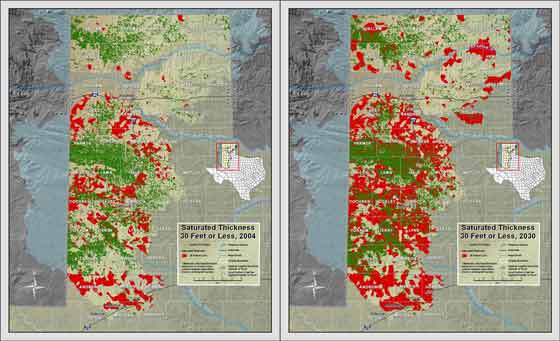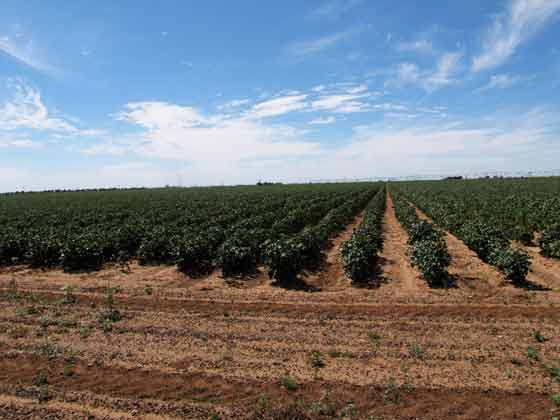[Editor’s note: This is an extended version of a 2010 interview we did with Lucia Barbato of the Texas Tech University Center for Geospatial Technology while filming a documentary about the courageous efforts of area producers (farmers), academic researchers, and local government agencies to extend the life of the Ogallala Aquifer. For those who have seen the original documentary, you may wish to jump ahead to 2:30, where the new extended interview takes place. The short beginning was used to provide an overall perspective of the region, and put into proper context why this is such an important problem that many individuals and organizations are seeking to find solutions.]
Lucia Barbato explains the various maps of the ogalla Aquifer in the Texas High Plains region. The Ogallala Aquifer formed millions of years ago, and no longer has an effective recharge capacity. This finite, fossil water resource will one-day run dry.

The central question is this: taking into account the competing interests of the various stakeholders that depend upon the Ogallala Aquifer for their economic well-being, what can be done to effectively extend the life of the aquifer balanced against the short-term needs of area producers who require enough water to successfully grow and raise their crops and livestock. Ratcheting the stakes further, these producers must also contend with extended periods of drought conditions (2011 was an exceptional drought year; 2012 and 2013 were also drought years) that requires more irrigation water usage, not less. Average annual rainfall is 18 inches, 2011 produced only 5.86 inches for that year. But even when rainfall levels approach the average level, it’s the distribution amounts, and the timing of when the rainfall actually occurs, that matters more. On a day-to day basis during the growing season, when temperatures and humidity levels are high — and when precipitation levels are correspondingly low — water irrigation needs go up.

Against this backdrop, there are also cultural values and legal rights questions that makes any proposed public policy remedies fraught with volatility. Both under Texas state law that grants ownership of water rights to landowners where water exists under the surface of their land, and to the political temperament of the people in the region who oppose government regulation out of principle—some may resort to litigation (possibly, violence) to protect what they see as their inherent rights of self-survival and freedom from outside interference to conduct their own affairs.
Despite all this, there were a representative group of producers from 3 (out of 16) counties in the area who volunteered to have their water metered, and to work together with researchers and government agencies to figure out better ways to reduce their water consumption, improve their farming practices, and avail their farms with more efficient irrigation systems to serve as potential models for others to follow.
As an outsider, the solution may seem relatively clear: stop monoculture farm production altogether in the region, and switch to more diversified and integrated farming systems that requires less water and less land to irrigate.
Of course, this is too simplistic even if it were possible to gain such cooperation. This is one of the largest contiguous areas of agricultural production in the country growing mostly monoculture cotton and corn. For 60 plus years, the Texas High Plains has developed around irrigated farming, to drastically reduce the use of water from the Ogallala Aquifer overnight would likely result in the substantial demise of agriculture production in the Southern High Plains region. The agricultural sector is estimated to contribute 28% to the region’s economy. Whatever solutions are able to be found and implemented, including integrating and diversifying farm operations, they may have to take place incrementally over time—perhaps decades— to be accomplished. How much time do these producers really have, without an effective recharge rate for the aquifer, as their main supply of water continues to decline?
The stated public policy goals are intended to extend the aquifer’s life as long as possible through the rationing of water usage, and gradual transitioning to farming systems that require less irrigated water without threatening the producer’s economic viability. The whispered hope, extending the useful life of the aquifer just long enough, perhaps technological solutions may emerge that will allow for long-range agricultural survival beyond the realm of what’s possible today.
What ultimately plays out on the Southern High Plains of Texas with the Ogallala Aquifer has global implications for other parts of the world that face their own water scarcity issues.
Watch the documentary Water Scarcity on the Texas High Plains: The Ogallala Aquifer for a ground-level view of what some of the local stakeholders are doing to extend the life of the Ogallala Aquifer, and to preserve the agricultural economy of the region.
Additional Resources:
- That Sinking Feeling About Groundwater in Texas— National Geographic, July 2012
- Texas Farmers Battle Ogallala Pumping Limits— Texas Tribune, March 2012
- Not a Drop to Drink: The Global Water Crisis— Council on Foreign Relations, May 2012
Most of the videos featured on Cooking Up a Story were produced, filmed, and edited by Rebecca Gerendasy. Fred Gerendasy contributed as a writer to many of the posts and occasionally as the interviewer. Visit Rebecca Gerendasy Clay – Art and Fred Gerendasy Photography to see their current work.
